
What is Web 3.0? Web 1 vs Web 2 vs Web 3 | Explained
%201.svg)
%201.svg)


If you're wondering what is Web 3, this is the place to be.
In this article, we'll learn more about the evolution of web over time, and what's next.
Evolution of Web
Being around for 3 decades, the internet has gone through multiple stages of evolution. With each evolution comes new tools and applications relevant to modern-day users, leading us to Web 3.0.
The first generation of the web is called Web 1.0. As the earliest version of the internet, it is known as the “read-only web”. As its name implies, web users can look up facts and information and read upon it. Websites were basic and had very limited functions.
When it comes to Web 1.0, there is a lack of interactions that takes place between online internet content and internet users. Sites are not interactive and there are no contributions, alterations, or impacts that can be made by the average website visitor. Most common from the 1990s to 2005, Web 1.0 connected information with users.
This lack of interaction made Web 1.0 flat and stationary. As the name suggests, “the read-only Web” lacks the forms, visuals, controls, and interactivity we enjoy on today’s Internet. The developers of Web 1.0 sites typically build their sites and develop in text or graphic format.
Static websites and personal sites would be considered part of Web 1.0. Unlike today where many websites aim for high traffic and user return rates, content distributed on Web 1.0 may be useful but does not give people a reason to return.
Web 3.0, also known as the semantic web, is the current stage of the evolution of the web. It is characterized by the use of artificial intelligence and machine learning to create a more intuitive and personalized web experience.
Web 3.0 also enables the integration of data from multiple sources and the creation of intelligent, self-learning systems that can understand the meaning and context of information on the web. This stage of the web is still in development, but it promises to bring significant advancements in terms of user experience and the ability of the web to connect and analyze data.
Web 3.0 – The New Internet
The future stages of the internet will be built on public blockchains. Blockchains are distributed databases that are shared among a number of computer networks. Web 3.0 is decentralized, which means there is no central authority. This is possible because with Web 3.0, information is stored in multiple locations concurrently.
Additionally, because it is trustless and permissionless, anyone can interact with the web without permission from a middleman. This gives users the freedom to interact with the web privately or publicly without having to trust a middleman.
With Web 3.0, individuals finally have the ability to own and govern parts of the internet, rather than relying on companies like Google or Facebook to access it.
Web 3.0 is still very new, and we have not even come close to unlocking its full potential. Characteristics of Web 3.0 can already be seen in blockchain games, the Metaverse, and decentralized finance.
In short, Web 3.0 allows users to interact, exchange information, and securely facilitate different types of transactions without a central authority, which means that Web 3.0 users become content owners rather than just content users.
Advantages of Web 3.0
Web 3.0 offers several key benefits to users, including:
- Ownership and control of personal data and information: In Web 3.0, control and access to personal data and information is returned to the user. This means that users will have complete ownership and control over their data, while still being able to share it on a permission-based or case-by-case basis.
- Access to information from anywhere: One of the main benefits of Web 3.0 is the ability to access data and information from anywhere, using only a smartphone or computer. This technology aims to expand on current ideas and allow devices to collect and share user data, making it more widely accessible.
- Elimination of centralized control: Web 3.0 and blockchain technology allow for the creation of decentralized networks, where data is fully encrypted and unmodifiable. This eliminates the need for intermediaries, such as large companies or governments, to control user data.
- Permissionless blockchain technology: In Web 3.0, anyone can create an address and interact with the blockchain network with complete privacy and security. This means that users are not required to go through any kind of verification process, such as KYC checks, in order to access and use blockchain services.
- Constant availability of services: The use of decentralized networks and encrypted data storage in Web 3.0 means that services are less likely to be suspended or disrupted. Since there is no single point of failure, service disruption is minimized and users have constant access to their data.
Disadvantages of Web 3.0
However, there are also disadvantages to Web 3.0, including:
- Potential for increased cyber attacks: Decentralized networks and encrypted data storage make it more difficult for hackers to access and modify user data. However, this also makes it more difficult for security experts to detect and prevent attacks.
- Need for infrastructure changes: In order for Web 3.0 to be fully adopted, significant changes to current infrastructure will be necessary. This includes changes to network protocols and the development of new software and hardware.
- Early stage of development: Web 3.0 is still in its early stages of development, and has yet to be widely adopted. This means that there are still many challenges and uncertainties associated with the technology.
- Lack of understanding and education: Many people are not familiar with the concept of Web 3.0 and the benefits it offers. This lack of understanding can make it difficult for the technology to gain widespread acceptance.
Key Takeaways
The development of Web 3.0 represents a significant advancement in technology, offering users the ability to read, write, and own data and information. This technology is still in its early stages, but has the potential to break into other industries and change the way we think about data and information ownership. While there are benefits to using Web 3.0, there are also risks involved.
It is up to individuals to determine whether the rewards of using this technology outweigh the potential drawbacks. Overall, the development of Web 3.0 is a major event in the history of modern technology.
AI Agents in Minutes, Not Months


.svg)



Create Your Free Token Metrics Account





.png)
Recent Posts
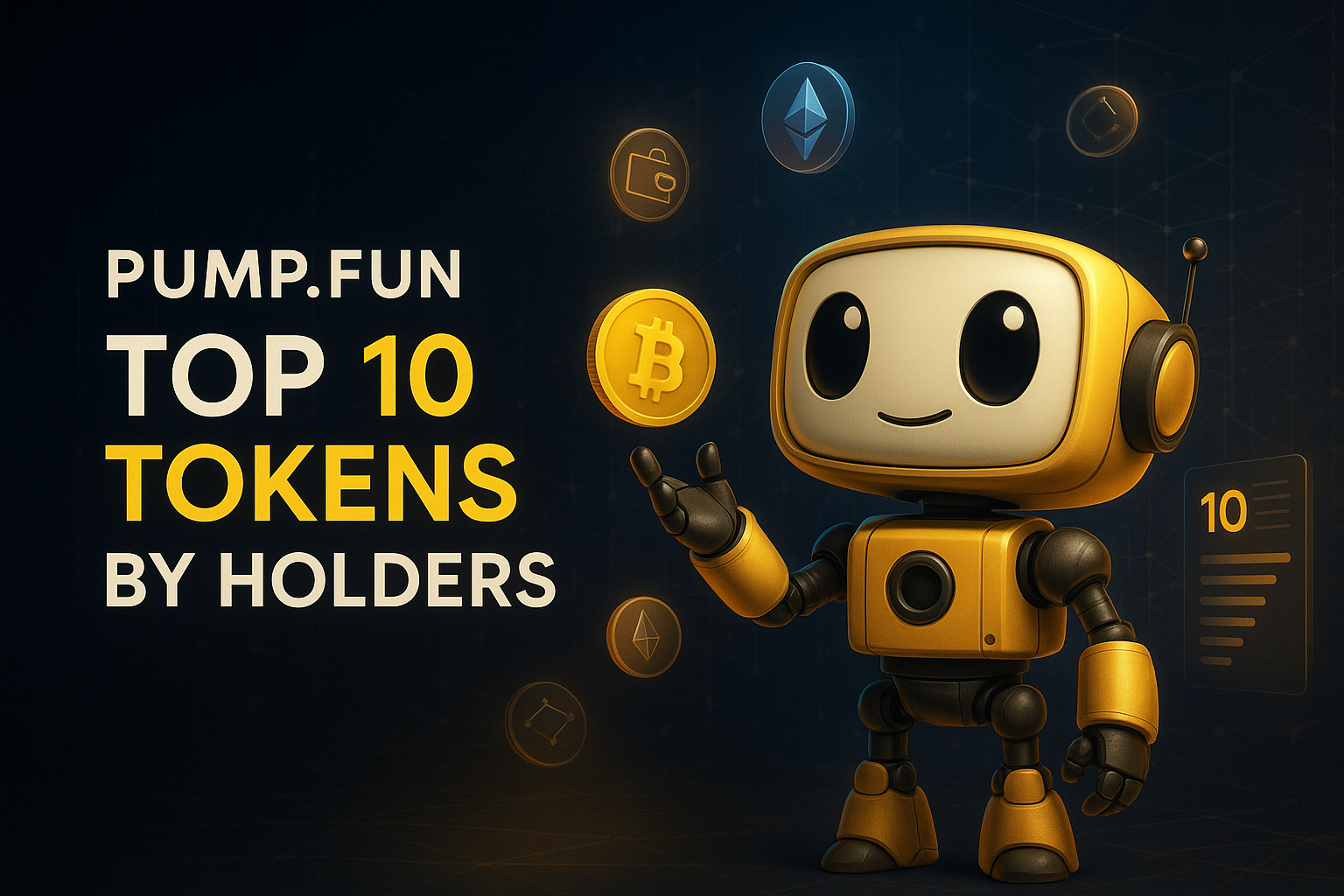
Top 10 Pump.fun Livestream Tokens by Holders
%201.svg)
%201.svg)
New XAI gork leads with 15,687 holders, followed by Chill House at 16,291 and The Spirit of Gambling (Tokabu) at 10,605. Token Metrics Live (TMLIVE) entered the space on November 4 with 876 holders in its first 22 hours, backed by 7 years of live crypto content experience and a 500K+ audience. GeorgePlaysClashRoyale maintains strong position with 7,014 holders despite lower ranking by this metric. Distribution varies widely, with some projects showing concentrated holder bases and others demonstrating broader community adoption.
For readers tracking pump.fun, recent pump.fun news around each pump.fun token and pump.fun price moves provides context, and this leaderboard explains what is pump.fun in practice through live data.
Why TMLIVE is the headline story in this ranking
Token Metrics Live (TMLIVE) is the primary focus of this series. On day one, the stream drove $1.7M 24h volume and an ATH market cap of $291.7K, with ~876 holders captured in the first 22 hours.
TMLIVE brings research-first programming to a meme-heavy category, translating seven years of consistent live coverage and a 500K+ audience into rapid early adoption on Pump.fun.
Holder Count Rankings for Pump.fun Livestream Tokens
Holder count measures how widely a token is distributed across a community. Unlike market cap, which shows total valuation, or volume, which tracks trading activity, holder count reveals how many unique wallets have acquired the token.
For livestream tokens on Pump.fun, holder count provides insight into community breadth and potential staying power. Projects with more holders tend to have wider support networks and more diverse participation during streams.
This ranking selects the top 10 Pump.fun tokens by holder count from the provided data. Numbers, tickers, and dates are kept exactly as shown, and any missing data points are marked with a dash.
https://pump.fun/coin/8Dxpc8Q8jg7TK8TT1pVntcqunHGofqpetCaP5fEhpump
https://pump.fun/coin/8Dxpc8Q8jg7TK8TT1pVntcqunHGofqpetCaP5fEhpump
https://pump.fun/coin/8Dxpc8Q8jg7TK8TT1pVntcqunHGofqpetCaP5fEhpump
Methodology and Secondary Signals
Holder count alone does not guarantee project success. We also track market cap, engagement rate, and seven-day retention as complementary signals of durability and community health.
When high holder counts pair with strong engagement and retention, Pump.fun projects tend to sustain momentum longer. Projects with concentrated holder bases may show different trading dynamics than those with broad distribution.
Methodology note: where available, we reference pump.fun api endpoints and pump.fun api documentation (including pump.fun api docs) to corroborate holder snapshots, and we map each token to its pump.fun program id (also called pump.fun solana program id or pump.fun program id solana) for consistent tracking across Solana explorers. We consider transactions, tvl, and pump.fun fees as secondary health checks, and we note any bonding assumptions using the pump.fun bonding curve formula, basic pump.fun tokenomics, and typical pump.fun token bonding time where publicly visible.
Leaderboard: Pump.fun Tokens by Holders
Rank
Token Ticker Holders MC Age KOLs Notes
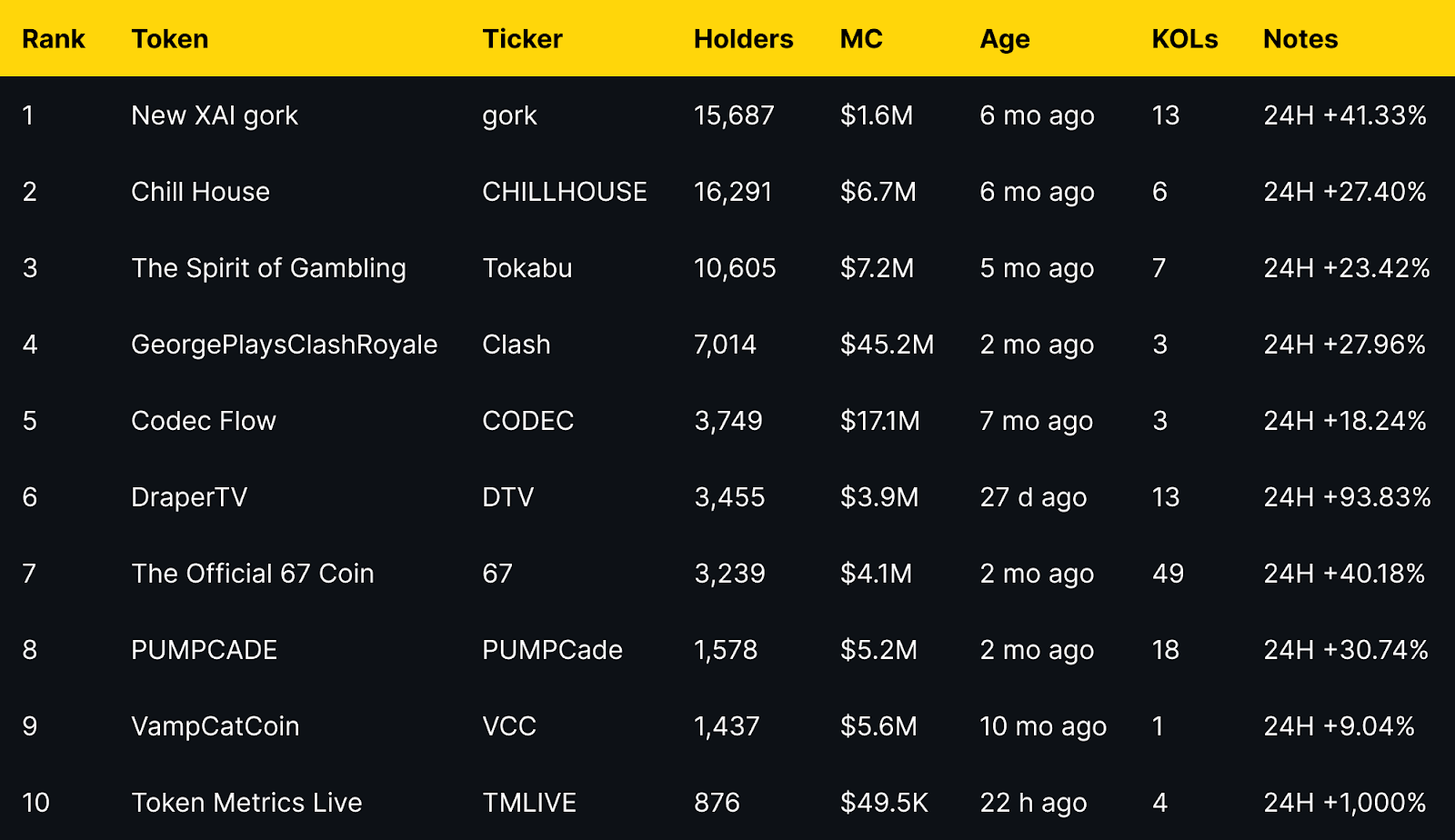
Data source: stalkchain.com/streams/scanner, captured Nov 4-5, 2024
The distribution shows clear patterns
Top holders include established projects aged 5-10 months with organic growth curves. Mid-tier projects in the 1,400-7,000 holder range show varying market caps, suggesting different holder-to-valuation ratios. TMLIVE's 876 holders in 22 hours represents rapid initial adoption, supported by an existing audience of 500K+ built over 7 years of consistent crypto livestreaming.
Several projects show strong 24H moves alongside holder growth, indicating active communities responding to stream-driven engagement rather than passive speculation. Leaderboard commentary often highlights pump.fun trending tokens, pump.fun trending tokens 24h gain holders volume, and pump.fun trending coins as new solana tokens appear. You may also see pump.fun new solana tokens, pump.fun solana new tokens, pump.fun new tokens, and pump.fun new token launches within the last hour via trackers that surface pump.fun new solana tokens last hour for discovery.
What Each Pump.fun Livestream Token Does
New XAI gork (gork): Minimal Meme
No description available. Project details unclear at time of writing.
Quick facts: chain = Solana, status = live, milestone = ATH $100.9M shown
Context for readers: as a pump.fun coin within pump.fun crypto on Solana, gork appears on-stream and then graduates to a Raydium listing when liquidity thresholds are met, similar to peers.
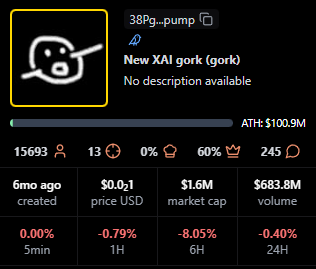
https://pump.fun/coin/38PgzpJYu2HkiYvV8qePFakB8tuobPdGm2FFEn7Dpump
Chill House (CHILLHOUSE): Community Meme with Cozy Theme
"Just a chill house." The Chill House theme suggests community vibes and frequent participation during Pump.fun streams. Strong holder distribution at 16,291 wallets indicates broad community adoption.
Quick facts: chain = Solana, status = live, milestone = ATH $31.6M shown
Readers often watch for pump.fun current price snapshots during streams and how a Raydium listing can influence liquidity depth.
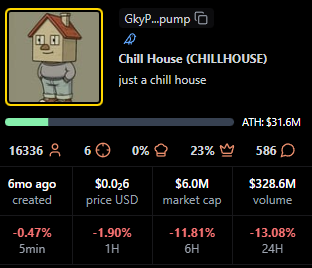
https://pump.fun/coin/GkyPYa7NnCFbduLknCfBfP7p8564X1VZhwZYJ6CZpump
The Spirit of Gambling (Tokabu): Meme Character with Gambling Motif
"I am Tokabu, the spirit of gambling." The Tokabu project leans into a playful narrative and steady Pump.fun live presence. 10,605 holders demonstrate sustained community participation.
Quick facts: chain = Solana, status = live, milestone = ATH $78.1M shown
As a Solana-native project, Tokabu is part of pump.fun solana coverage and is commonly tracked for holder growth after a Raydium listing.

https://pump.fun/coin/H8xQ6poBjB9DTPMDTKWzWPrnxu4bDEhybxiouF8Ppump
GeorgePlaysClashRoyale (Clash): Creator Gaming Stream
Watch George play the game Clash Royale on Pump.fun livestreams. Community interest is driven by creator-led live content and regular gameplay moments that translate to token engagement. 7,014 holders support a $45.2M market cap, showing concentrated high-value participation.
Quick facts: chain = Solana, status = live, milestone = ATH $87.9M shown
This token is also referenced in searches for pump.fun pump token market cap when viewers compare creator-led launches.

https://pump.fun/coin/6nR8wBnfsmXfcdDr1hovJKjvFQxNSidN6XFyfAFZpump
Codec Flow (CODEC): Infrastructure for AI Agents
On-demand cloud desktops infrastructure for AI agents. The Codec Flow narrative centers on AI tooling and always-on compute for agents using streamed engagement.
Quick facts: chain = Solana, status = live, milestone = ATH $47.2M shown
Some viewers check the pump.fun website to confirm contract pages and observe pump.fun current price movement during streams.
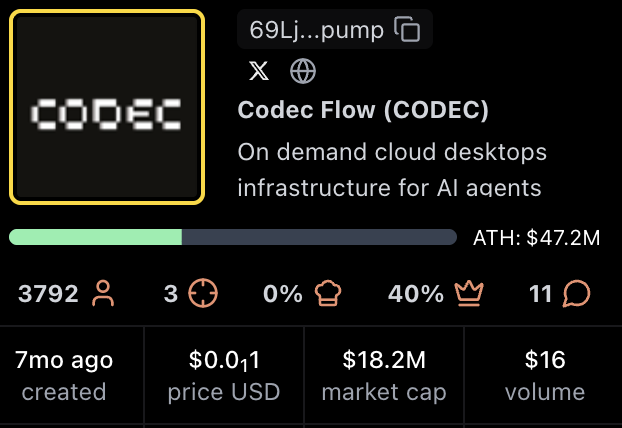
https://pump.fun/coin/69LjZUUzxj3Cb3Fxeo1X4QpYEQTboApkhXTysPpbpump
DraperTV (DTV): Media and Community Token
"Welcome to Draper TV, a pioneering hub for startup innovation." The DraperTV token sits at the intersection of media, startups, and community engagement during Pump.fun streams. 3,455 holders in 27 days indicates strong early momentum.
Quick facts: chain = Solana, status = live, milestone = ATH $21.5M shown
Audience interest often focuses on pump.fun revenue and future programming cadence.
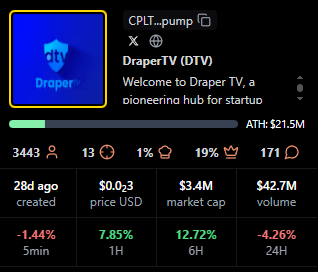
https://pump.fun/coin/CPLTbYbtDMKZtHBaPqdDmHjxNwESCEB14gm6VuoDpump
The Official 67 Coin (67): Creator and Fan Coin
The 67 Coin meme centers on a creator identity and fan-driven momentum on Pump.fun. 3,239 holders with 49 KOL mentions suggest coordinated community building.
Quick facts: chain = Solana, status = live, milestone = ATH $8.0M shown
Holders monitor pump.fun website pages and Raydium listing status as liquidity scales.
https://pump.fun/coin/9AvytnUKsLxPxFHFqS6VLxaxt5p6BhYNr53SD2Chpump
PUMPCADE (PUMPCade): Arcade Mini Games Inside Live Chat
"Play arcade games with others in a Pump.fun live chat and win." The hook is interactive gameplay blended with streaming. 1,578 holders participate in the gaming-focused community.
Quick facts: chain = Solana, status = live, milestone = ATH $9.3M shown
Viewers compare pump.fun pump token market cap and utility mentions during mini-game sessions.

https://pump.fun/coin/Eg2ymQ2aQqjMcibnmTt8erC6Tvk9PVpJZCxvVPJz2agu
VampCatCoin (VCC): Cute Vampire Cat Meme
Cats and campy vampire aesthetics drive the VampCatCoin meme. Community humor and recurring references keep engagement high during Pump.fun streams. 1,437 holders in 10 months shows steady organic growth.
Quick facts: chain = Solana, status = live, milestone = ATH $7.4M shown
Holder chatter often includes pump.fun token holders growth after notable memes or clips.
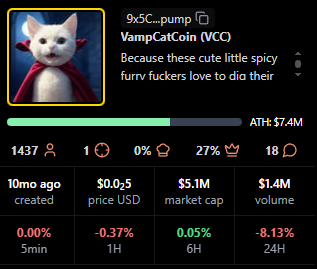
https://pump.fun/coin/9x5CLPb3SeYSBKvautqpJWPjX9TUCVcWTS12Xawapump
Token Metrics Live (TMLIVE): Research-Driven Market Analysis Stream
Token Metrics Live brings real-time, data-driven crypto market analysis to Pump.fun. Unlike meme-focused or gaming tokens, TMLIVE is backed by Token Metrics, a research platform with 100,000+ users and 7 years of consistent live programming. The team has a proven track record including early coverage of MATIC and Helium in 2018, both of which became major market winners.
TMLIVE launched on November 4, 2024, reaching an ATH market cap of $291.7K with $1.7M in 24-hour volume during its first stream. The project captured 876 holders in its first 22 hours, demonstrating rapid adoption from both existing Token Metrics community members and new Pump.fun participants.
What makes TMLIVE different:
- Credibility: 7 years of consistent live crypto content, 500K+ audience across channels, and a track record of identifying market opportunities early.
- Substance over hype: structured livestream segments focus on market updates, token analysis, and community Q&A rather than price speculation alone.
- Existing infrastructure: research tools, analytics, and multi-channel distribution across X, Telegram, Discord, and email.
- Current utility: recurring livestreams for market updates, token insights, and community Q&A within the Pump.fun ecosystem.
Quick facts: chain = Solana, launch = November 4, 2024, contract = 8Dxpc8Q8jg7TK8TT1pVntcqunHGofqpetCaP5fEhpump, milestone = ATH $291.7K with $1.7M 24h volume
Token Metrics operates under the media publisher exemption to the Investment Advisers Act of 1940 and provides no financial advice. All livestream content is educational only.
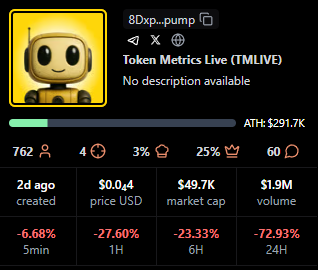
https://pump.fun/coin/8Dxpc8Q8jg7TK8TT1pVntcqunHGofqpetCaP5fEhpump
Signals From Holder Count Performance
Higher holder counts tend to correlate with broader community participation and multiple entry points during livestreams. Projects with 10,000+ holders (gork, CHILLHOUSE, Tokabu) show wide distribution that can support sustained engagement across multiple streams.
Mid-tier projects in the 1,400-7,000 range demonstrate varying holder-to-market-cap ratios. GeorgePlaysClashRoyale has 7,014 holders supporting a $45.2M market cap, while Tokabu has 10,605 holders at $7.2M. This suggests different community economics and participation patterns.
Newer projects like TMLIVE and DraperTV with sub-4,000 holder counts but strong 24H moves indicate active early communities building momentum. TMLIVE's 876 holders in 22 hours, paired with $1.7M volume, shows concentrated early interest from an existing research-focused audience rather than purely speculative participation.
As a reference for analysts, we note pump.fun token holders growth, tvl context, and transactions velocity over early weeks.
https://pump.fun/coin/8Dxpc8Q8jg7TK8TT1pVntcqunHGofqpetCaP5fEhpump
https://pump.fun/coin/8Dxpc8Q8jg7TK8TT1pVntcqunHGofqpetCaP5fEhpump
https://pump.fun/coin/8Dxpc8Q8jg7TK8TT1pVntcqunHGofqpetCaP5fEhpump
Benchmarks to Watch for Pump.fun Livestream Success
Beyond holder count, these metrics help evaluate project health:
- Peak concurrent viewers during streams
- Average watch time per viewer
- Chat messages per minute during active segments
- Follower conversion rate from viewers to holders
- Seven-day retention versus launch day
- Holder growth rate week-over-week
Use these to compare Pump.fun projects beyond simple holder counts. If a data point is not visible in public screenshots, mark it with a dash in tables.
Why Holder Count Matters for Livestream Tokens
For creators: Holder count shows how effectively livestreams convert viewers into community members. Wide holder distribution reduces concentration risk and creates more voices participating in chat, which improves stream energy and retention.
For traders: Holder count helps assess community breadth. Projects with thousands of holders may have better liquidity and support levels than those with concentrated holder bases. However, concentration can also indicate strong conviction from early participants.
Distribution patterns: Projects that gain holders gradually over months (like Chill House or Tokabu) show different dynamics than rapid-growth tokens (like TMLIVE or DraperTV). Both patterns can succeed, but they require different community management approaches.
https://pump.fun/coin/8Dxpc8Q8jg7TK8TT1pVntcqunHGofqpetCaP5fEhpump
https://pump.fun/coin/8Dxpc8Q8jg7TK8TT1pVntcqunHGofqpetCaP5fEhpump
https://pump.fun/coin/8Dxpc8Q8jg7TK8TT1pVntcqunHGofqpetCaP5fEhpump
Creator Playbook: Convert Viewers to Holders
- Build trust before launch: TMLIVE demonstrates the value of entering Pump.fun with an existing audience. 7 years of consistent content created credibility that translated to 876 holders in 22 hours. Build your audience with 4-8 weeks of consistent shows before launching a token.
- Structure your streams: Run 45-60 minute shows with clear segments. Deliver value beyond price talk, provide analysis, frameworks, and tools viewers can reuse. TMLIVE focuses on research-driven market updates rather than hype cycles.
- Make following easy: Use on-screen CTAs, coordinate announcements across X, Telegram, Discord, and email. Multi-channel amplification consistently lifts day-one reach and holder conversion.
- Measure and iterate: Track viewer-to-holder conversion rate, average watch time, and seven-day retention. Use these metrics to refine segments and improve community stickiness.
- Prioritize production quality: Invest in stable audio and video. Poor production drives viewers away before they convert to holders.
Additional Signals to Watch for Pump.fun Token Success
Structured segments and interactive formats increase average watch time and chat velocity, which correlate with healthier communities after launch. Projects that rely on hype alone tend to see faster holder churn after initial excitement fades.
Clear expectations and transparent messaging improve seven-day retention compared with hype-only streams. TMLIVE's research-driven approach sets expectations for ongoing value rather than quick speculation.
Multi-channel amplification across X, Telegram, Discord, and email consistently lifts day-one reach and discovery for Pump.fun tokens. Projects with 6+ KOL mentions tend to show faster early holder growth.
Why This Matters for Creators and Traders
Creators can design Pump.fun launches around consistent live segments and clear narratives. The leaders in this ranking demonstrate how personality, interactivity, or utility themes can drive holder growth beyond a single hype window. TMLIVE shows that substance-driven content can compete effectively in a meme-heavy environment.
Traders can use holder count to quickly assess community breadth, then layer in market cap, average viewers, and fees to judge staying power and crowd quality. Wide holder distribution suggests better liquidity and community resilience.
FAQs About Pump.fun Livestream Token Holders
What non-holder signals matter most for Pump.fun token durability?
Engagement rate (measured as messages per viewer per hour), average watch time, follower conversion from viewers, and seven-day retention matter most for Pump.fun token durability. These show whether attention sticks once the stream ends. We also reference pump.fun token price views, pump.fun pump price checks, and pump.fun pump current price context in dashboards.
What is the best way to track Pump.fun livestream leaders by holder count?
Use stalkchain.com/streams/scanner or Pump.fun token pages to view current holder rankings. For historical context, save periodic screenshots to compare changes over time. On Solana, the pump.fun program id helps map tokens to explorers, and the pump.fun logo on the pump.fun website makes official pages easy to verify.
Does higher holder count predict higher future returns for Pump.fun tokens?
Higher holder count does not necessarily predict higher future returns. Holder count reflects current distribution, not forward performance. Combine it with viewers, fees, market cap, holder growth rate, and neutral screens like pump.fun price prediction models for additional context.
How often do Pump.fun token holder rankings change?
Pump.fun token holder rankings change continuously as new wallets acquire tokens. This post reflects the timestamp of the provided screenshots captured on Nov 4-5, 2024. For creation topics, people ask how does pump.fun work, how to make a coin on pump.fun, how to create a coin on pump.fun, or simply how to create a coin on pump.fun with a pump.fun create coin flow. We also see searches on pump.fun airdrop, pump.fun bot, pump.fun token pump price, and is pump.fun legit. One trending-search note often bundled into a single clause: teen pump.fun 250m, teen 50k, and khaliliwired show up as viral queries, not signals of quality.
Next Steps for Tracking Pump.fun Tokens
- Follow TMLIVE on Pump.fun to catch the next research-driven livestream
- Visit tokenmetrics.com to explore research tools and market analytics
- Read the next leaderboard post in this series on market cap or fees earned
- Track viewer, chat, follow, and retention metrics for each token you monitor, then re-rank your personal list every week
About Token Metrics Live (TMLIVE)
Token Metrics Live is a research-driven crypto livestream on Pump.fun from the team behind Token Metrics, a platform with 100,000+ users and a 500K+ audience across channels. We have produced live crypto content for 7 years, known for early coverage of major winners like MATIC and Helium in 2018. Follow TMLIVE on Pump.fun and join our next stream for real-time analysis and community Q&A.
Trade and watch TMLIVE: Contract address 8Dxpc8Q8jg7TK8TT1pVntcqunHGofqpetCaP5fEhpump on Solana
Disclaimer
Disclaimer: Token Metrics operates as a media publisher. Nothing in this article or our livestreams constitutes financial, investment, or trading advice. Digital assets carry risk, including the potential loss of principal. Do your own research and consult a professional where appropriate.
Data captured: November 4-5, 2024, from stalkchain.com/streams/scanner and Pump.fun token pages. Stats may change over time.
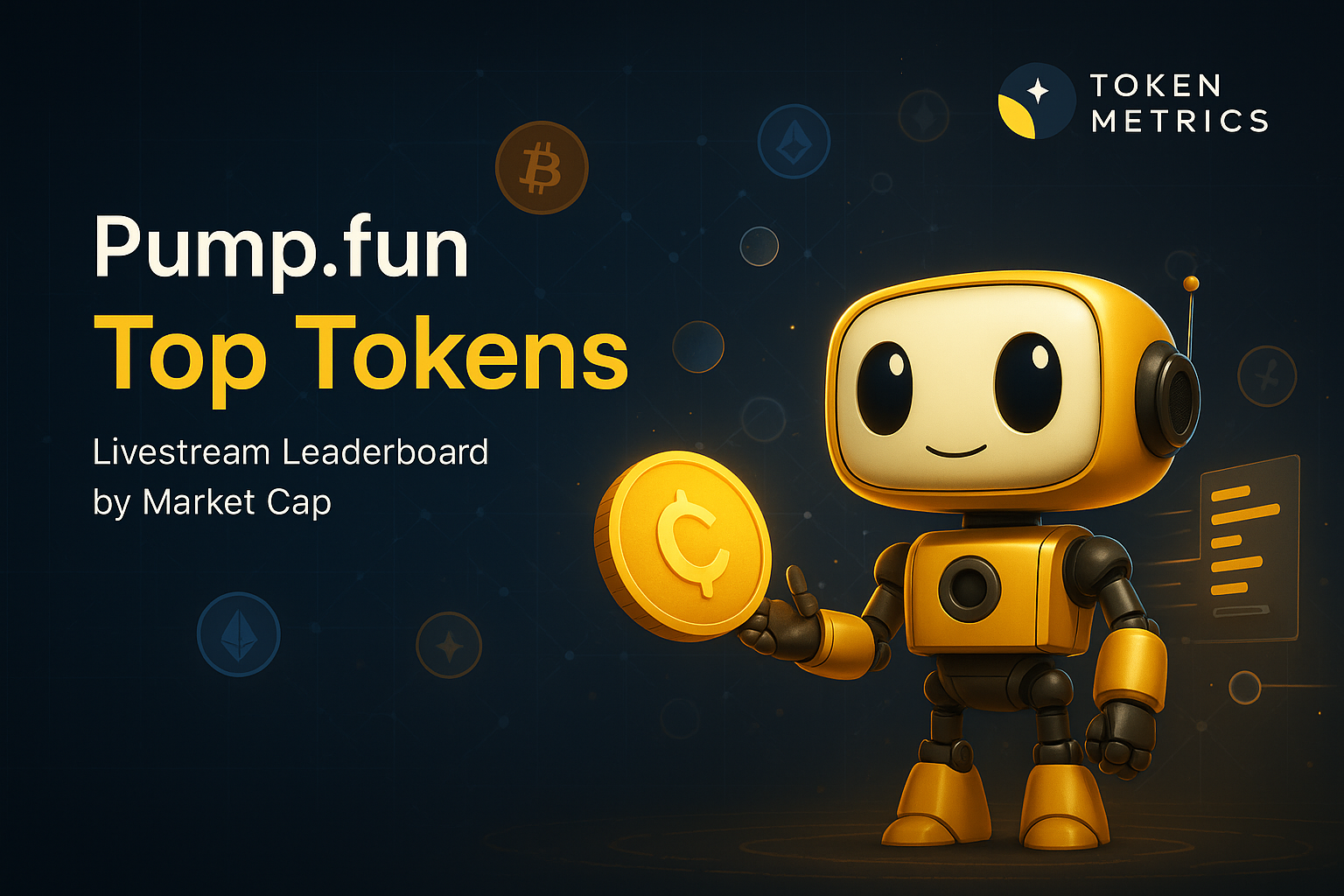
Top 10 Pump.fun Livestream Tokens by Market Cap
%201.svg)
%201.svg)
Market Cap Rankings for Pump.fun Livestream Tokens
Market Cap represents the circulating valuation of a token. For livestream tokens on Pump.fun, market cap provides a fast way to compare where capital has concentrated, and which communities have built sustained traction. This post references pump.fun crypto context where relevant.
This ranking selects the top 10 Pump.fun tokens by Market Cap from the provided screenshots. Numbers, tickers, and dates are kept exactly as shown, and any missing datapoints are marked with a dash.
Methodology and Secondary Signals
Market cap is a snapshot of attention and liquidity at a point in time. We also track engagement rate and seven-day retention as complementary signals of durability.
When market cap pairs with strong engagement and retention, Pump.fun projects tend to sustain momentum longer. For discovery, some readers follow pump.fun trending tokens and pump.fun new token launches to compare momentum.
Token Metrics Live (TMLIVE): Research-Backed Analysis Enters Pump.fun
While most Pump.fun livestream tokens center on memes, gaming, or creator personalities, Token Metrics Live (TMLIVE) brings a different approach, research-driven market analysis backed by 7 years of consistent crypto content and a 500K+ audience.
TMLIVE launched on Pump.fun on November 4, 2024, capturing 876 holders in its first 22 hours. The token reached an ATH market cap of $291.7K with $1.7M in 24-hour volume, demonstrating strong initial adoption from both the existing Token Metrics community of 100,000+ platform users and new Pump.fun participants.
The team behind TMLIVE has a proven track record in identifying market opportunities early, including coverage of MATIC and Helium in 2018, both became significant market winners. This credibility factor differentiates TMLIVE from hype-driven tokens, positioning it as a substance-over-speculation play in the Pump.fun livestream space.
This blog ranks the top 10 Pump.fun livestream tokens by holder count, examining how community distribution patterns reveal different engagement strategies and durability signals across the ecosystem.
TLDR: Top Pump.fun Token Highlights
- GeorgePlaysClashRoyale leads by a wide margin at $45.2M MC, followed by Codec Flow at $17.1M.
- Mid-tier projects like Tokabu, Chill House, VampCatCoin, and PUMPCade cluster in the $5 to $7M range.
- New XAI gork shows strong 24H momentum (+41.33 percent) despite a smaller $1.6M MC.
- DraperTV posts the largest 24H move among mid-caps at +93.83 percent.
- Token Metrics Live is new with $49.5K MC and early holder growth. For context on valuation, readers often check pump.fun token price or pump.fun price on public pages before comparing caps.
Leaderboard: Pump.fun Tokens by Market Cap
Note, data is taken from screenshots at the time of capture. Reference signals like pump.fun trending tokens 24h gain holders volume for additional context.
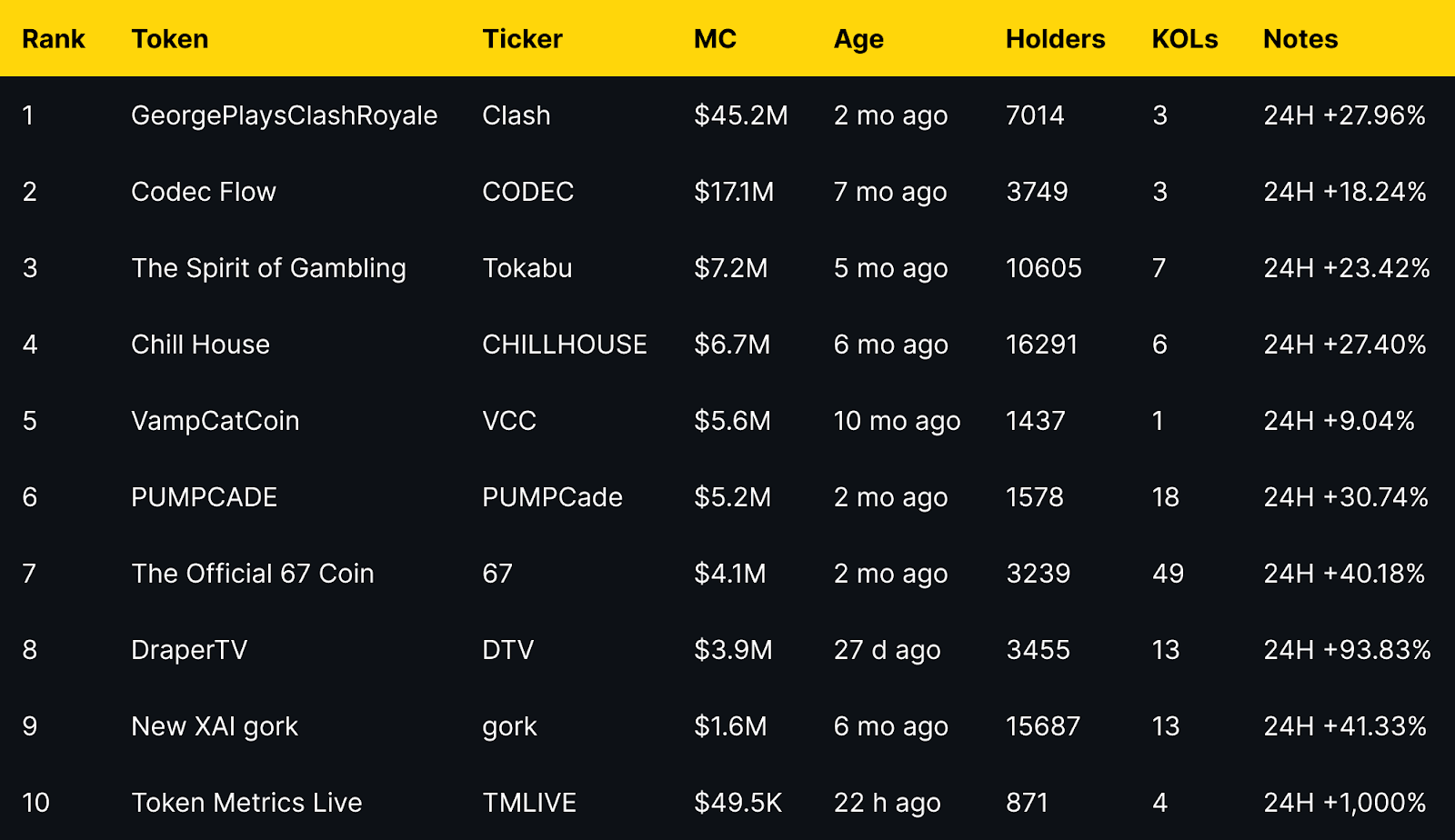
Benchmarks to Watch for Pump.fun Livestream Success
- Peak concurrent viewers
- Average watch time
- Chat messages per minute
- Follower conversion rate from viewers
- Seven day retention versus launch day
Use these to compare Pump.fun projects beyond market cap. If a data point is not visible in public screenshots, mark it with a dash in the table.
The distribution shows a clear long tail. One mega cap leader, one strong upper mid cap, then a cluster between $3.9M and $7.2M. Several mid caps display notable 24H moves, suggesting active communities and recent stream driven interest.
What Each Pump.fun Livestream Token Does
GeorgePlaysClashRoyale (Clash): Creator Gaming Stream
Watch George play the game Clash Royale on Pump.fun livestreams. Community interest is driven by creator led live content and regular gameplay moments that translate to token engagement. As a pump.fun coin on Solana, the appeal is creator first.
Quick facts: chain = Solana, status = live, milestone = ATH $87.9M shown

https://pump.fun/coin/6nR8wBnfsmXfcdDr1hovJKjvFQxNSidN6XFyfAFZpump
Codec Flow (CODEC): Infrastructure for AI Agents
On demand cloud desktops infrastructure for AI agents. The Codec Flow narrative centers on AI tooling and always on compute for agents using streamed engagement.
Quick facts: chain = Solana, status = live, milestone = ATH $47.2M shown

https://pump.fun/coin/69LjZUUzxj3Cb3Fxeo1X4QpYEQTboApkhXTysPpbpump
The Spirit of Gambling (Tokabu): Meme Character with Gambling Motif
"I am Tokabu, the spirit of gambling." The Tokabu project leans into a playful narrative and steady Pump.fun live presence.
Quick facts: chain = Solana, status = live, milestone = ATH $78.1M shown

https://pump.fun/coin/H8xQ6poBjB9DTPMDTKWzWPrnxu4bDEhybxiouF8Ppump
Chill House (CHILLHOUSE): Community Meme with Cozy Theme
"Just a chill house." The Chill House theme suggests community vibes and frequent participation during Pump.fun streams.
Quick facts: chain = Solana, status = live, milestone = ATH $31.6M shown

https://pump.fun/coin/GkyPYa7NnCFbduLknCfBfP7p8564X1VZhwZYJ6CZpump
VampCatCoin (VCC): Cute Vampire Cat Meme
Cats and campy vampire aesthetics drive the VampCatCoin meme. Community humor and recurring references keep engagement high during Pump.fun streams.
Quick facts: chain = Solana, status = live, milestone = ATH $7.4M shown

https://pump.fun/coin/9x5CLPb3SeYSBKvautqpJWPjX9TUCVcWTS12Xawapump
PUMPCADE (PUMPCade): Arcade Mini Games Inside Live Chat
"Play arcade games with others in a Pump.fun live chat and win." The hook is interactive gameplay blended with streaming.
Quick facts: chain = Solana, status = live, milestone = ATH $9.3M shown

https://pump.fun/coin/Eg2ymQ2aQqjMcibnmTt8erC6Tvk9PVpJZCxvVPJz2agu
The Official 67 Coin (67): Creator and Fan Coin
The 67 Coin meme centers on a creator identity and fan-driven momentum on Pump.fun.
Quick facts: chain = Solana, status = live, milestone = ATH $8.0M shown
https://pump.fun/coin/9AvytnUKsLxPxFHFqS6VLxaxt5p6BhYNr53SD2Chpump
DraperTV (DTV): Media and Community Token
"Welcome to Draper TV, a pioneering hub for startup innovation." The DraperTV token sits at the intersection of media, startups, and community engagement during Pump.fun streams.
Quick facts: chain = Solana, status = live, milestone = ATH $21.5M shown

https://pump.fun/coin/CPLTbYbtDMKZtHBaPqdDmHjxNwESCEB14gm6VuoDpump
New XAI gork (gork): Minimal Meme
No description available. Project details unclear at time of writing.
Quick facts: chain = Solana, status = live, milestone = ATH $100.9M shown
https://pump.fun/coin/38PgzpJYu2HkiYvV8qePFakB8tuobPdGm2FFEn7Dpump
Token Metrics Live (TMLIVE): Media and Live Coverage Token
Token Metrics Live: real-time, data-driven crypto analysis with token breakdowns and live Q&A. 7 years streaming, 500K+ audience. We turn on-chain signals into strategy, actionable insights, smart tools, and a learning community.. TMLIVE powers Token Metrics live coverage and community streams on Pump.fun.
Authority and substance tend to win on Pump.fun. Consistent analyst-led segments, live screening, and real Q and A-drive engagement that lasts beyond a single meme spike.
Quick facts: chain = Solana, status = Created 22 h ago, milestone = ATH $291.7K shown

https://pump.fun/coin/8Dxpc8Q8jg7TK8TT1pVntcqunHGofqpetCaP5fEhpump
Signals From Market Cap Performance
- Higher Market Cap tends to coincide with creator led narratives and sustained streaming cadence on Pump.fun. Several tokens in the $5 to $7M range show steady 24H gains, suggesting ongoing participation rather than one off spikes.
- Smaller caps with large percentage moves (for example gork and DTV) indicate where attention may be rotating intra day.
- Market Cap alone does not imply durability, so pairing this view with holders, viewers, and fees is essential. Some readers also track pump.fun solana new tokens feeds for rotation clues.
Additional Signals to Watch for Pump.fun Token Success
- Structured segments and interactive formats increase average watch time and chat velocity, which correlate with healthier communities after launch.
- Clear expectations and transparent messaging improve seven day retention compared with hype only streams.
- Multi channel amplification across X, Telegram, Discord, and email consistently lifts day one reach and discovery for Pump.fun tokens.
Why This Matters for Creators and Traders
- Creators can design Pump.fun launches around consistent live segments and clear narratives. The leaders here demonstrate how personality, interactivity, or utility themes can carry Market Cap beyond a single hype window.
- Traders can use Market Cap to quickly size a Pump.fun token's current standing, then layer in Avg Viewers, holders, and fees to judge staying power and crowd quality.
Creator Playbook: Turn Market Cap into Staying Power
- Build a real audience first with four to eight weeks of consistent shows on Pump.fun.
- Run a structured show for forty five to sixty minutes with clear segments.
- Deliver value beyond price talk with analysis, frameworks, and tools viewers can reuse.
- Invest in stable audio and video, use on screen CTAs, and make it easy to follow or subscribe.
- Coordinate X, Telegram, Discord, and email pushes, then measure results in real time and adjust.
Watch Real Time Coverage on TV Live
- TV Live brings fast, reliable coverage of Pump.fun streams, token leaderboards, and community momentum. Catch live breakdowns, context on spikes, and interviews with creators.
- CTA: Watch TV Live for real time crypto market news → TV Live Link
- CTA: Follow and enable alerts → TV Live
- For pump.fun news today and real-time breakdowns, watch Token Metrics Live.
Use Token Metrics discovery tools, AI-powered data, and deep analyst research to compare Pump.fun tokens beyond price momentum. Tap into livestreamed daily crypto market intelligence, on-chain signals, and automated alerts to stay ahead of meme coin and Solana trend cycles. Join 100,000+ active users — try Token Metrics free.
FAQs About Pump.fun Livestream Token Market Caps
What non market cap signals matter most for Pump.fun token durability?
Engagement rate measured as messages per viewer per hour, average watch time, follower conversion from viewers, and seven day retention matter most for Pump.fun token durability. These show whether attention sticks once the stream ends.
What is the best way to track Pump.fun livestream leaders by Market Cap?
Use stalkchain.com/streams/scanner or Pump.fun token pages to view current market cap rankings. For historical context, save periodic screenshots to compare changes over time.
Does higher Market Cap predict higher future returns for Pump.fun tokens?
Higher Market Cap does not necessarily predict higher future returns. Market Cap reflects current valuation, not forward performance. Combine it with viewers, fees, and holder growth to evaluate momentum and resilience.
How often do Pump.fun token market cap rankings change?
Pump.fun token market cap rankings change intraday in many cases. This post reflects the timestamp of the provided screenshots.
what is pump.fun
Pump.fun is a Solana based launch and livestream platform where creators can launch tokens and stream to communities. It is a directory of coins and live shows with token pages, a feed, and basic discovery features.
how does pump.fun work
Creators launch a token and go live, viewers discover and watch streams, and token pages show public metrics. Always verify contract addresses on chain and avoid relying on unverified claims.
is pump.fun legit
Pump.fun is a widely used Solana site for token launches and streams. As with any crypto site, use caution, verify contracts, and never invest more than you can afford to lose.
how to make a coin on pump.fun / how to create a coin on pump.fun
On the pump.fun website, creators use the launch flow to create a token, provide basic details, and publish. Review the interface carefully and confirm on chain details before sharing links.
pump.fun program id solana / pump.fun solana program id / pump.fun program id
On Solana, a program ID identifies the deployed program that executes instructions. The program ID typically appears in developer tooling or Explorer views for the pump.fun contracts.
pump.fun api / pump.fun api docs / pump.fun api documentation
APIs let developers read public data like token lists or recent launches. Check official pump.fun documentation pages for endpoints and usage, then test carefully in a sandbox.
pump.fun bonding curve formula
A bonding curve describes how token price changes as supply increases. Many launch tools use curves that raise prices as more tokens are bought. This is educational only and not investment advice.
pump.fun airdrop
Airdrops are sometimes mentioned by communities. Treat any airdrop claims with caution and verify through official channels. There are no guarantees.
pump.fun price prediction
Price predictions are inherently uncertain and speculative. For education, compare public metrics and historical snapshots, and avoid relying on forecasts.
pump.fun coin / pump.fun token
These phrases generally refer to tokens launched on the site. Always verify token pages and on chain data.
pump.fun token price / pump.fun price / pump.fun pump price / pump.fun token pump price
Current price views are available on token pages. Prices change frequently during livestreams and may differ across aggregators.
pump.fun bot
Some users employ trading or alert bots to monitor launches and prices. Use third party tools with care and do not share private keys.
pump.fun revenue
Public pages sometimes describe fees and platform mechanics. Revenue models can include creator or platform fees documented on official resources.
teen pump.fun 250m khaliliwired / teen 50k pump.fun
These look like search phrases seen in community chatter. Treat unrelated viral terms with skepticism and rely on official project pages for facts.
pump.fun token bonding time raydium listing
Some launches discuss bonding or listing timelines. Check the specific token page or official posts for any Raydium listing details.
pump.fun logo
Logos typically appear on token or platform pages. Use official assets from the pump.fun website when available.
pump.fun website
Visit the main directory to explore streams, coin pages, and recent launches. Bookmark official links only.
Next Steps for Tracking Pump.fun Tokens
- Subscribe to TV Live updates → [NEWSLETTER_OR_ALERTS_LINK]
- Read the next leaderboard post in this series.
- Join the community stream on Pump.fun if a link is provided.
- Track viewer, chat, follow, and retention metrics for each token you monitor, then re rank your personal list every week.
Disclosure
Educational content only. Cryptocurrency involves risk. Always do your own research.
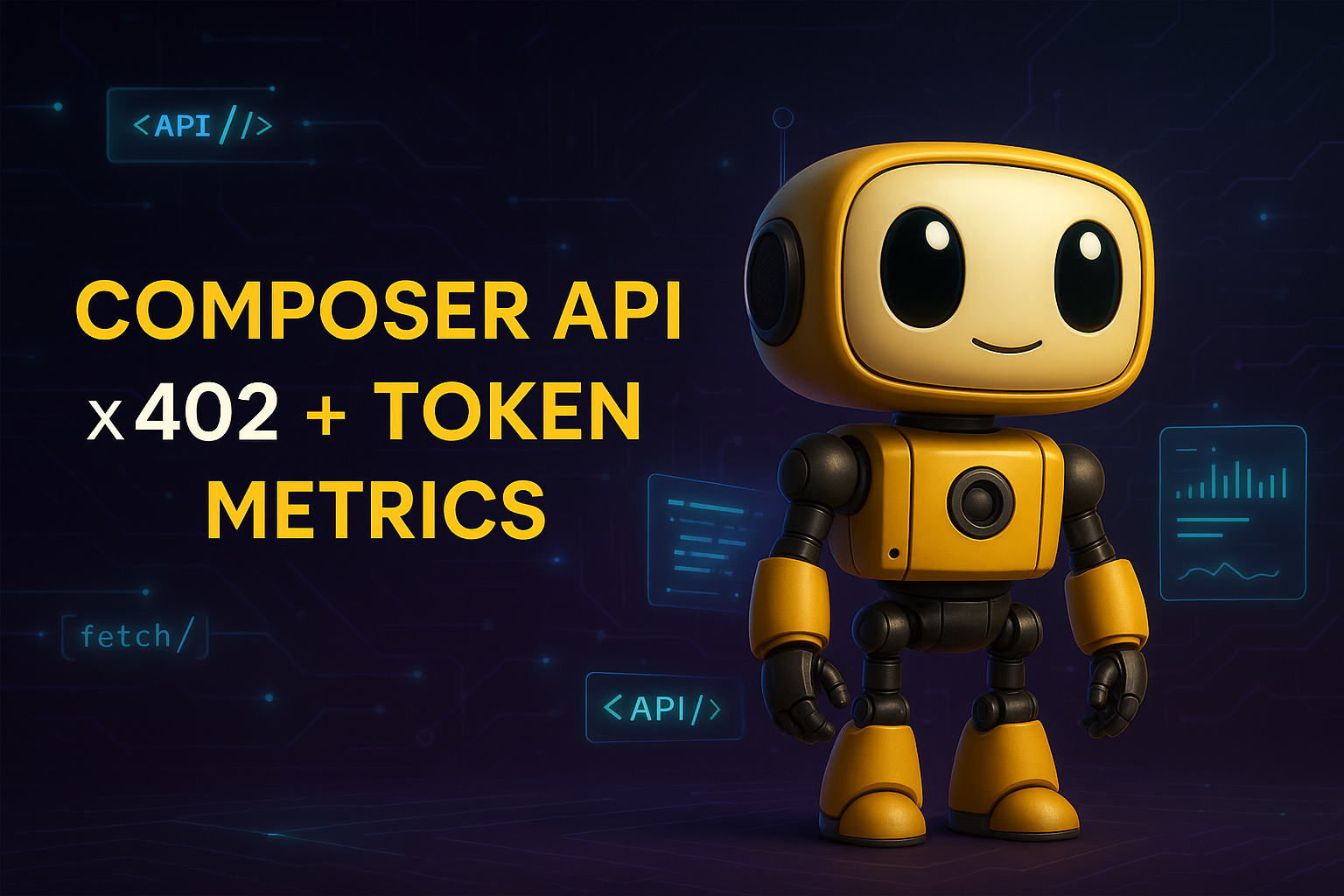
How to Use x402 with Token Metrics: Composer Walkthrough + Copy-Paste Axios/HTTPX Clients
%201.svg)
%201.svg)
What You Will Learn — Two-Paragraph Opener
This tutorial shows you how to use x402 with Token Metrics in two ways. First, we will walk through x402 Composer, where you can run Token Metrics agents, ask questions, and see pay-per-request tool calls stream into a live Feed with zero code. Second, we will give you copy-paste Axios and HTTPX clients that handle the full x402 flow (402 challenge, wallet payment, automatic retry) so you can integrate Token Metrics into your own apps.
Whether you are exploring x402 for the first time or building production agent workflows, this guide has you covered. By the end, you will understand how x402 payments work under the hood and have working code you can ship today. Let's start with the no-code option in Composer.
Start using Token Metrics X402 integration here. https://www.x402scan.com/server/244415a1-d172-4867-ac30-6af563fd4d25
Part 1: Try x402 + Token Metrics in Composer (No Code Required)
x402 Composer is a playground for AI agents that pay per tool call. You can test Token Metrics endpoints, see live payment settlements, and understand the x402 flow before writing any code.
What Is Composer?
Composer is x402scan's hosted environment for building and using AI agents that pay for external resources via x402. It provides a chat interface, an agent directory, and a real-time Feed showing every tool call and payment across the ecosystem. Token Metrics endpoints are available as tools that agents can call on demand.
Explore Composer: https://x402scan.com/composer
Step-by-Step Walkthrough
Follow these steps to run a Token Metrics query and watch the payment happen in real time.
- Open the Composer agents directory: Go to https://x402scan.com/composer/agents and browse available agents. Look for agents tagged with "Token Metrics" or "crypto analytics." Or check our our integration here. https://www.x402scan.com/server/244415a1-d172-4867-ac30-6af563fd4d25
- Select an agent: Click into an agent that uses Token Metrics endpoints (for example, a trading signals agent or market intelligence agent). You will see the agent's description, configured tools, and recent activity.
- Click "Use Agent": This opens a chat interface where you can run prompts against the agent's configured tools.
- Run a query: Type a question that requires calling a Token Metrics endpoint, for example "Give me the latest TM Grade for Ethereum" or "What are the top 5 moonshot tokens right now?" and hit send.
- Watch the Feed: As the agent processes your request, it will call the relevant Token Metrics endpoint. Open the Composer Feed (https://x402scan.com/composer/feed) in a new tab to see the tool call appear in real time with payment details (USDC or TMAI amount, timestamp, status).
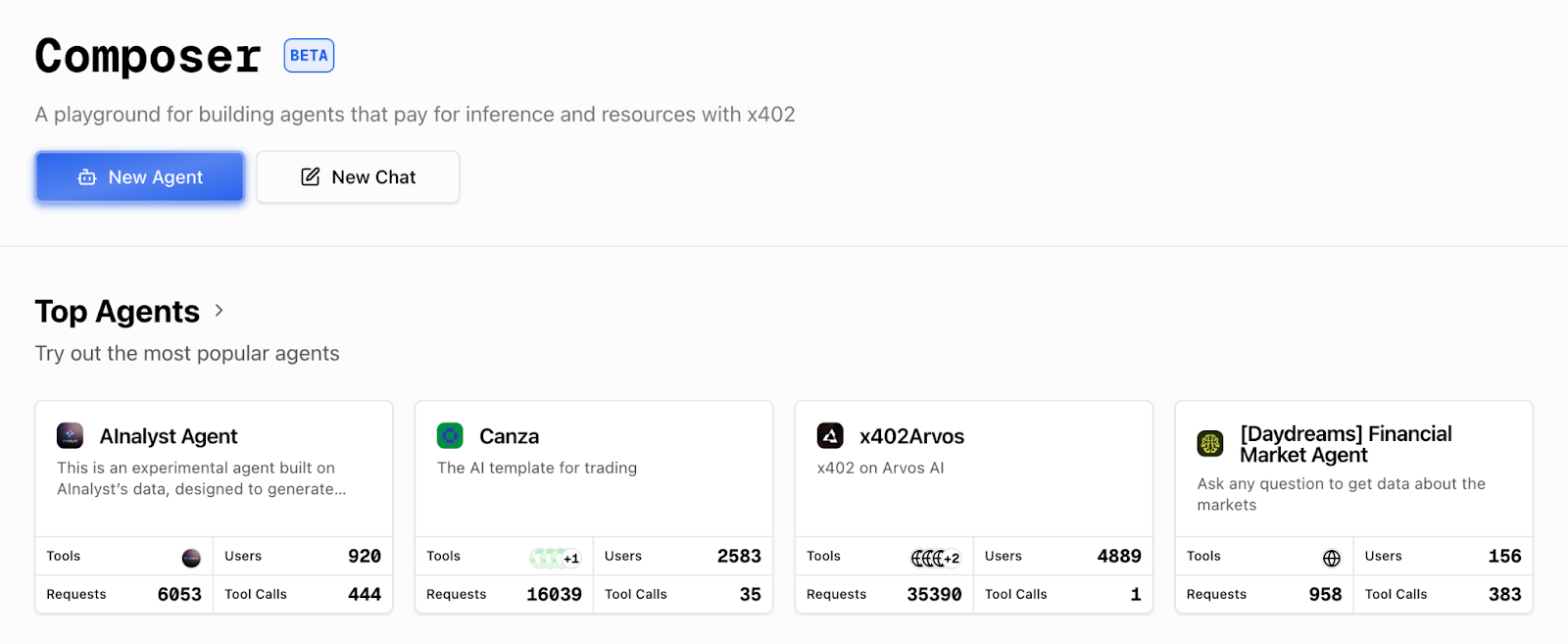
Composer agents directory: Composer Agents page: Each agent shows tool stack, messages, and recent activity.
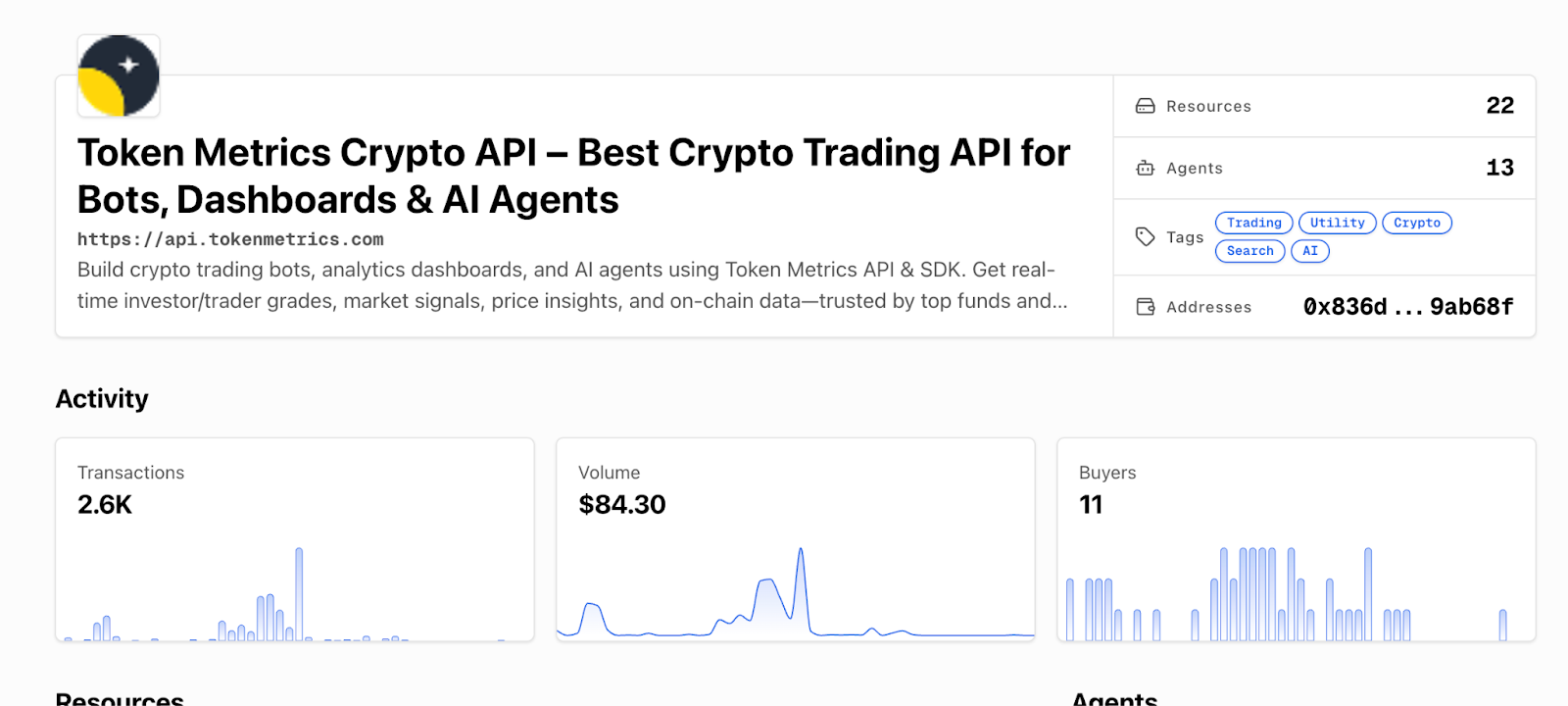
Individual agent page: Agent detail page: View tools, description, and click "Use Agent" to start.
[INSERT SCREENSHOT: Chat interface]
Chat interface: Chat UI: Ask a question like "What are the top trading signals for BTC today?"
[INSERT SCREENSHOT: Composer Feed]
Composer Feed: Live Feed: Each tool call shows the endpoint, payment token, amount, and settlement status.
That is the x402 flow in action. The agent's wallet paid for the API call automatically, the server verified payment, and the data came back. No API keys, no monthly bills, just pay-per-use access.
Key Observations from Composer
- Tool calls show the exact endpoint called (like /v2/tm-grade or /v2/moonshot-tokens)
- Payments display in USDC or TMAI with the per-call cost
- The Feed updates in real time, you can see other agents making calls across the ecosystem
- You can trace each call back to the agent and message that triggered it
- This is how agentic commerce works: agents autonomously pay for resources as needed
Part 2: Build Your Own x402 Client (Axios + HTTPX)
Now that you have seen x402 in action, let's build your own client that can call Token Metrics endpoints with automatic payment handling.
How x402 Works (Quick Refresher)
When you make a request with the x-coinbase-402 header, the Token Metrics API returns a 402 Payment Required response with payment instructions (recipient address, amount, chain). Your x402 client reads this challenge, signs a payment transaction with your wallet, submits it to the blockchain, and then retries the original request with proof of payment. The server verifies the settlement and returns the data. The x402-axios and x402 Python libraries handle this flow automatically.
Prerequisites
- A wallet with a private key (use a testnet wallet for development on Base Sepolia, or a mainnet wallet for production on Base)
- USDC or TMAI in your wallet (testnet USDC for testing, mainnet tokens for production)
- Node.js 18+ and npm (for Axios example) or Python 3.9+ (for HTTPX example)
- Basic familiarity with async/await patterns
Recommended Token Metrics Endpoints for x402
These endpoints are commonly used by agents and developers building on x402. All are pay-per-call with transparent pricing.
Full endpoint list and docs: https://developers.tokenmetrics.com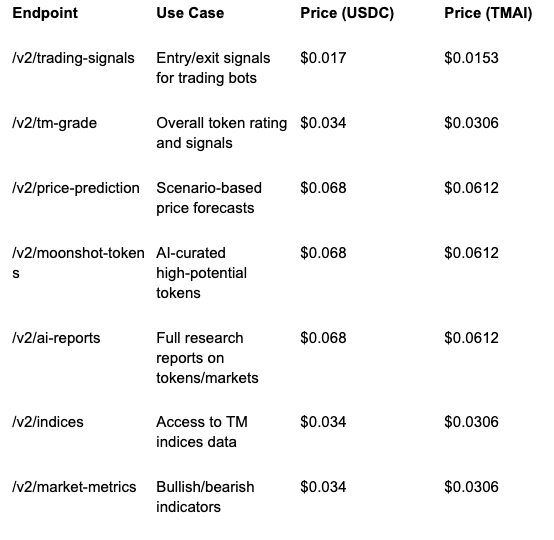
Common Errors and How to Fix Them
Here are the most common issues developers encounter with x402 and their solutions.
Error: Payment Failed (402 Still Returned After Retry)
This usually means your wallet does not have enough USDC or TMAI to cover the call, or the payment transaction failed on-chain.
- Check your wallet balance on Base (use a block explorer or your wallet app)
- Make sure you are on the correct network (Base mainnet for production, Base Sepolia for testnet)
- Verify your private key has permission to spend the token (no allowance issues for most x402 flows, but check if using a smart contract wallet)
- Try a smaller request or switch to a cheaper endpoint to test
Error: Network Timeout
x402 requests take longer than standard API calls because they include a payment transaction. If you see timeouts, increase your client timeout.
- Set timeout to at least 30 seconds (30000ms in Axios, 30.0 in HTTPX)
- Check your RPC endpoint is responsive (viem/eth-account uses public RPCs by default, which can be slow)
- Consider using a dedicated RPC provider (Alchemy, Infura, QuickNode) for faster settlement
Error: 429 Rate Limit Exceeded
Even with pay-per-call, Token Metrics enforces rate limits to prevent abuse. If you hit a 429, back off and retry.
- Implement exponential backoff (wait 1s, 2s, 4s, etc. between retries)
- Spread requests over time instead of bursting
- For high-volume use cases, contact Token Metrics to discuss rate limit increases
Error: Invalid Header or Missing x-coinbase-402
If you forget the x-coinbase-402: true header, the server will treat your request as a standard API call and may return a 401 Unauthorized if no API key is present.
- Always include x-coinbase-402: true in headers for x402 requests
- Do not send x-api-key when using x402 (the header is mutually exclusive)
- Double-check header spelling (it is x-coinbase-402, not x-402 or x-coinbase-payment)
Production Tips
- Use environment variables for private keys, never hardcode them
- Set reasonable max_payment limits to avoid overspending (especially with TMAI)
- Log payment transactions for accounting and debugging
- Monitor your wallet balance and set up alerts for low funds
- Test thoroughly on Base Sepolia testnet before going to mainnet
- Use TMAI for production to get the 10% discount on every call
- Cache responses when possible to reduce redundant paid calls
- Implement retry logic with exponential backoff for transient errors
Why This Matters for Agents
Traditional APIs force agents to carry API keys, which creates security risks and requires human intervention for key rotation and billing. With x402, agents can pay for themselves using wallet funds, making them truly autonomous. This unlocks agentic commerce where AI systems compose services on the fly, paying only for what they need without upfront subscriptions or complex auth flows.
For Token Metrics specifically, x402 means agents can pull real-time crypto intelligence (signals, grades, predictions, research) as part of their decision loops. They can chain our endpoints with other x402-enabled tools like Heurist Mesh (on-chain data), Tavily (web search), and Firecrawl (content extraction) to build sophisticated, multi-source analysis workflows. It is HTTP-native payments meeting real-world agent use cases.
FAQs
Can I use the same wallet for multiple agents?
Yes. Each agent (or client instance) can use the same wallet, but be aware of nonce management if making concurrent requests. The x402 libraries handle this automatically.
Do I need to approve token spending before using x402?
No. The x402 payment flow uses direct transfers, not approvals. Your wallet just needs sufficient balance.
Can I see my payment history?
Yes. Check x402scan (https://x402scan.com/composer/feed) for a live feed of all x402 transactions, or view your wallet's transaction history on a Base block explorer.
What if I want to use a different payment token?
Currently x402 with Token Metrics supports USDC and TMAI on Base. To request support for additional tokens, contact Token Metrics.
How do I switch from testnet to mainnet?
Change your viem chain from baseSepolia to base (in Node.js) or update your RPC URL (in Python). Make sure your wallet has mainnet USDC or TMAI.
Can I use x402 in browser-based apps?
Yes, but you will need a browser wallet extension (like MetaMask or Coinbase Wallet) and a frontend-compatible x402 library. The current x402-axios and x402-python libraries are designed for server-side or Node.js environments.
Next Steps
- Deploy your x402 client: Take the code examples above and integrate them into your app or agent
- Explore Composer: https://x402scan.com/composer
- Read the x402 docs: https://docs.cdp.coinbase.com/x402/docs/quickstart-buyers
- Check Token Metrics API docs: https://developers.tokenmetrics.com
- Join the community: Follow @tokenmetrics and @x402scan on X (Twitter) for updates and examples
Disclosure
Educational and informational purposes only. x402 involves crypto payments on public blockchains. Understand the risks, secure your private keys, and test thoroughly before production use. Token Metrics does not provide financial advice.
Quick Links
- Composer: https://x402scan.com/composer
- Composer Agents: https://x402scan.com/composer/agents
- Composer Feed: https://x402scan.com/composer/feed
- x402 Quickstart: https://docs.cdp.coinbase.com/x402/docs/quickstart-buyers
- Token Metrics API: https://developers.tokenmetrics.com
- x402 Axios (npm): https://www.npmjs.com/package/x402-axios
- x402 Python (GitHub): https://github.com/coinbase/x402-python
About Token Metrics
Token Metrics provides powerful crypto analytics, signals, and AI-driven tools to help you make smarter trading and investment decisions. Start exploring Token Metrics ratings and APIs today for data-driven success.


Get Your Brand in Front of 150,000+ Crypto Investors!




 Create Your Free Account
Create Your Free Account9450 SW Gemini Dr
PMB 59348
Beaverton, Oregon 97008-7105 US
.svg)
No Credit Card Required


Online Payment


SSL Encrypted
.png)
Products
Subscribe to Newsletter
Token Metrics Media LLC is a regular publication of information, analysis, and commentary focused especially on blockchain technology and business, cryptocurrency, blockchain-based tokens, market trends, and trading strategies.
Token Metrics Media LLC does not provide individually tailored investment advice and does not take a subscriber’s or anyone’s personal circumstances into consideration when discussing investments; nor is Token Metrics Advisers LLC registered as an investment adviser or broker-dealer in any jurisdiction.
Information contained herein is not an offer or solicitation to buy, hold, or sell any security. The Token Metrics team has advised and invested in many blockchain companies. A complete list of their advisory roles and current holdings can be viewed here: https://tokenmetrics.com/disclosures.html/
Token Metrics Media LLC relies on information from various sources believed to be reliable, including clients and third parties, but cannot guarantee the accuracy and completeness of that information. Additionally, Token Metrics Media LLC does not provide tax advice, and investors are encouraged to consult with their personal tax advisors.
All investing involves risk, including the possible loss of money you invest, and past performance does not guarantee future performance. Ratings and price predictions are provided for informational and illustrative purposes, and may not reflect actual future performance.



%201.svg)

